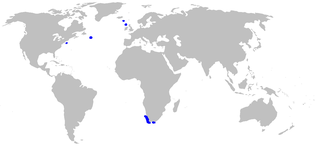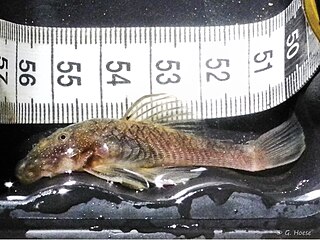
Pyrene is a polycyclic aromatic hydrocarbon (PAH) consisting of four fused benzene rings, resulting in a flat aromatic system. The chemical formula is C
16H
10. This yellow solid is the smallest peri-fused PAH. Pyrene forms during incomplete combustion of organic compounds.

Melamphaes microps, the smalleye bigscale or smalleye ridgehead is a fish of the genus Melamphaes, found in the North Atlantic, South Atlantic, southern Indian Ocean, and the south west Pacific including New Zealand, at depths of from 1,000 to 3,000 m. Their length is up to 10 cm.

The smalleye catshark is a catshark of the family Scyliorhinidae, found in the southeast Atlantic at depths between 700 and 2,000 m. It can grow up to 61 cm. The reproduction of this catshark is oviparous.
A blind fish is a fish without functional eyes. Most blind fish species are found in dark habitats such as the deep ocean, deep river channels and underground.
Pterosturisoma microps is the only species of the monotypic genus Pterosturisoma, a genus of the family Loricariidae of catfish.

Heteropneustes microps is a species of airsac catfish possibly endemic to Sri Lanka, though records from India have been made. This species grows to a length of 15.0 cm (5.9 in) TL. This fish is a component of local commercial fisheries, as well as being found in the aquarium trade.

The small-eyed whiting, Sillago microps, is a poorly known species of coastal marine fish of the smelt-whiting family Sillaginidae. The species is known from only two specimens; the holotype collected by Roland McKay in 1985 from a Taipei market, both specimens of which were taken from the waters of Taiwan. Apart from a relatively small eye size, the species is hard to distinguish from other common species of sillaginid taken in the area, and may be a minor part of local fisheries.

The common goby is a species of ray-finned fish native to fresh and brackish waters along the Atlantic and Baltic Sea coasts of Europe and northern Africa, with a range stretching from Norway to Morocco and Mauritania. It is also found in the Canary Islands. This species reaches a maximum length of 9 centimetres (3.5 in) TL.
Neoplecostomus microps is a species of armored catfish endemic to Brazil where it occurs in the Paraíba do Sul River basin. This species grows to a length of 10.2 centimetres (4.0 in) SL.
Chiloglanis microps is a species of upside-down catfish endemic to the Democratic Republic of the Congo where it occurs in the Lufira River system. This species grows to a length of 5.6 centimetres (2.2 in) SL.
Barbodes microps is a species of cyprinid fish endemic to Indonesia. This species can reach a length of 12.5 centimetres (4.9 in) TL.
Triplophysa microps is a species of ray-finned fish in the genus Triplophysa. It is found in shallow streams at the upper reaches of the Yellow, Yangtze, Salween, Mekong, Indus and Brahmaputra Rivers and also in alpine lakes in the Tibetan plateau.

The Modoc sucker is a rare species of freshwater fish native to northern California and southern Oregon. It grows to a length of about 7 in (18 cm) and becomes sexually mature at 4 in (10 cm). It feeds on algae, small invertebrates and detritus, and hides under stones, detritus and overhanging vegetation. It is found in only a few streams and is listed as an endangered species in California and the United States. Conservation measures have been put in place such as fencing the streams in which it lives from livestock. It was previously rated as "endangered" by the International Union for Conservation of Nature, but this rating has now been changed to "near threatened".
Sundasalanx, the Sundaland noodlefishes, is the only genus in the family Sundasalangidae, which belongs to the same order as the herrings and their relatives. This family of extremely small fishes is restricted to freshwater environments of Southeast Asia with Indonesia being home to the majority of species. The seven currently recognized species in this genus are:

Nebris is a small genus of fish in the family Sciaenidae.

Chaetostoma microps is a species of suckermouth armored catfish native to Ecuador. The fish has been filmed climbing cave walls.

Cottunculus microps, the polar sculpin, is a species of fathead sculpin, a deepwater fish found in the North Atlantic and Arctic Oceans. It was first described in 1875 by the Norwegian zoologist Robert Collett, curator of the Natural History Museum at the University of Oslo.
Parasinilabeo longicorpus is a species of cyprinid fish endemic to China.
Parasinilabeo longiventralis is a species of cyprinid fish endemic to the Fuchuanjiang River in China.
Parasinilabeo maculatus is a species of cyprinid fish endemic to China.









